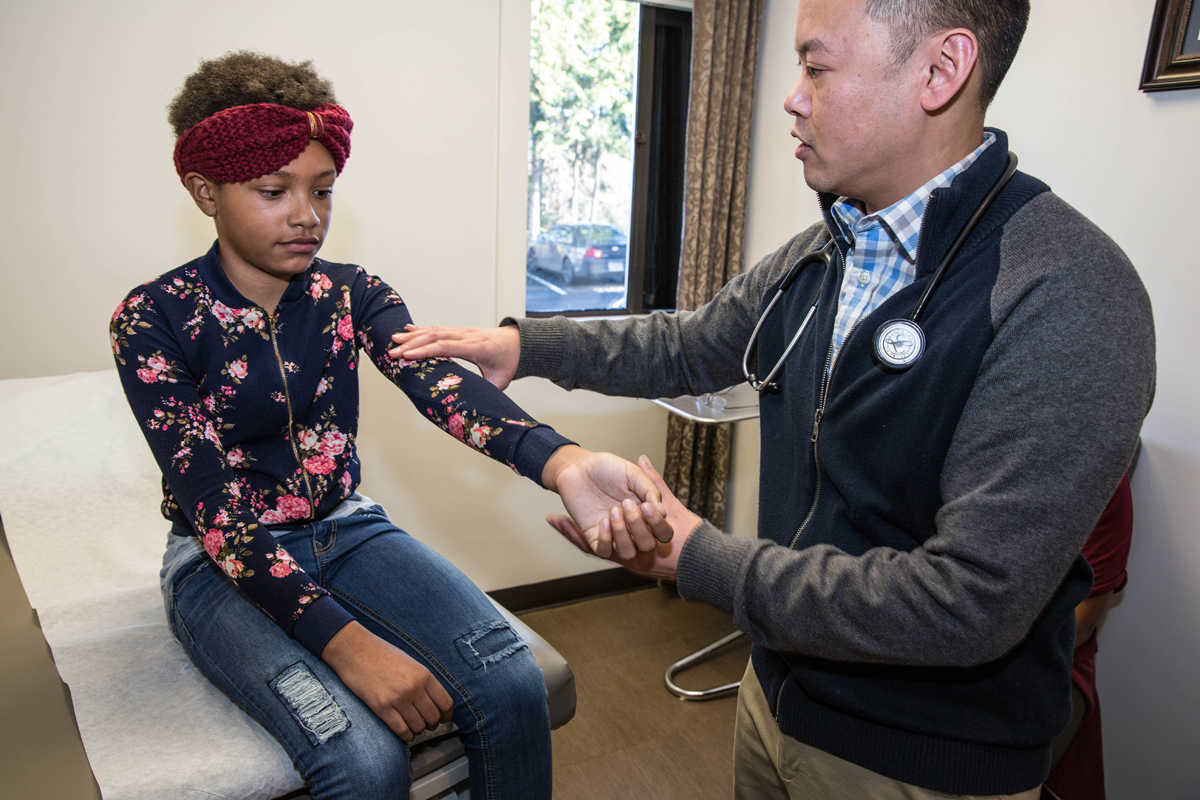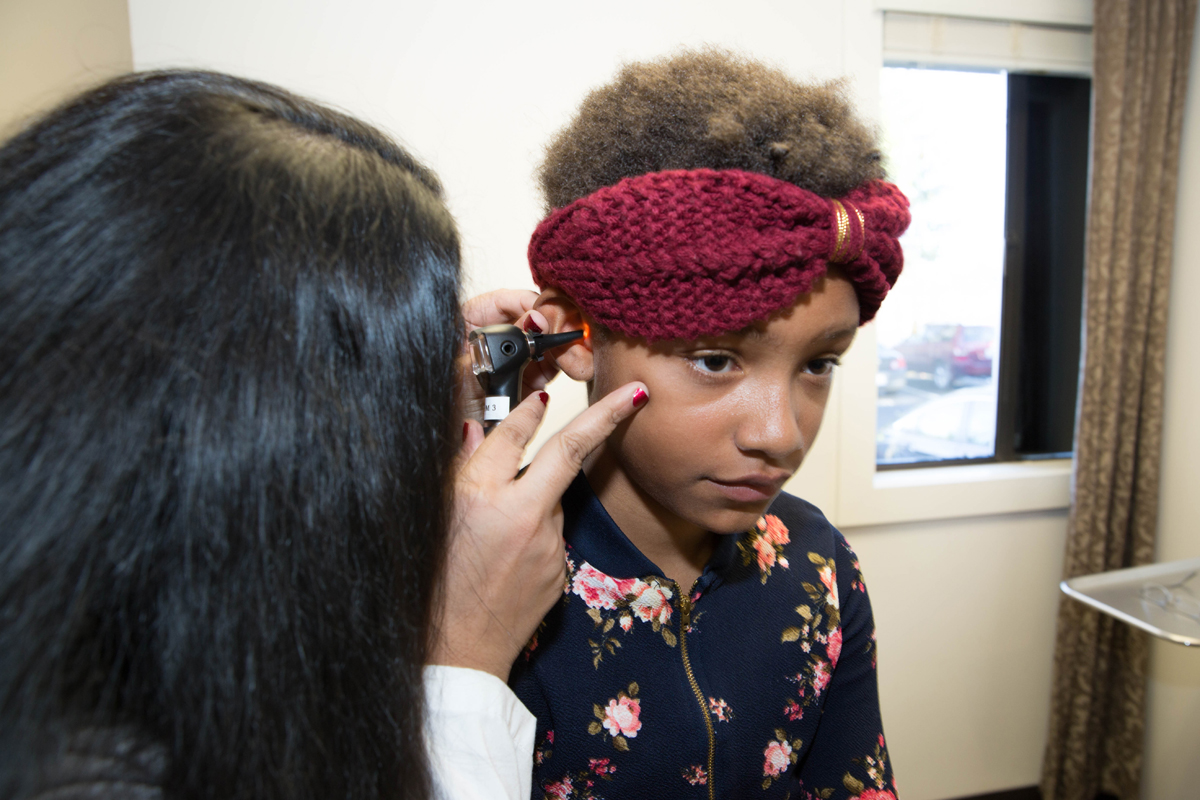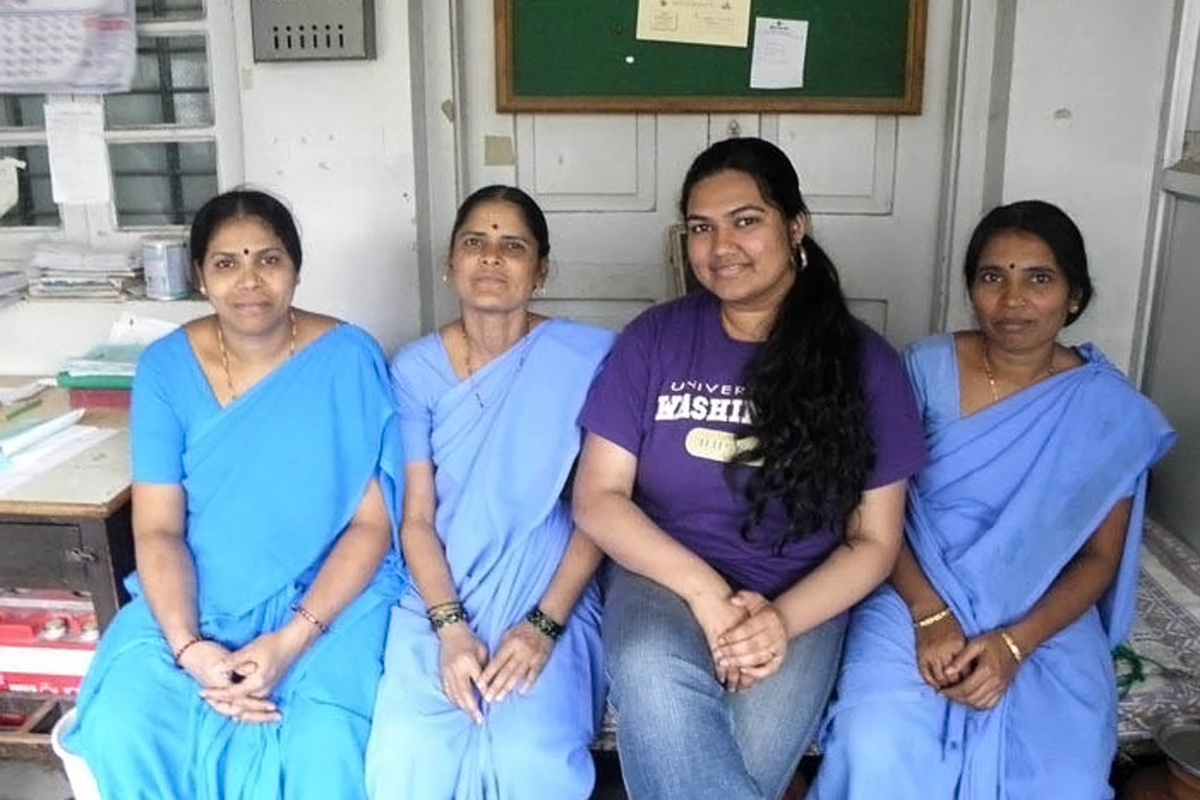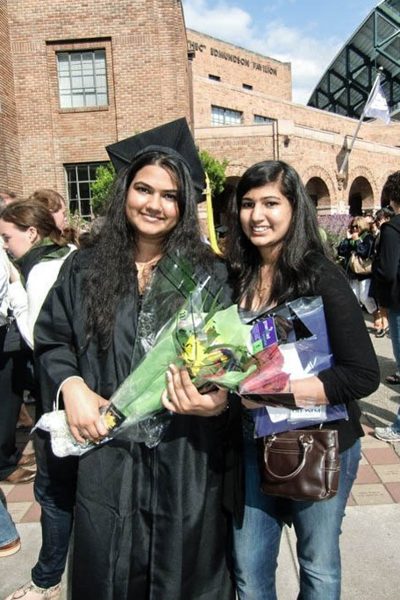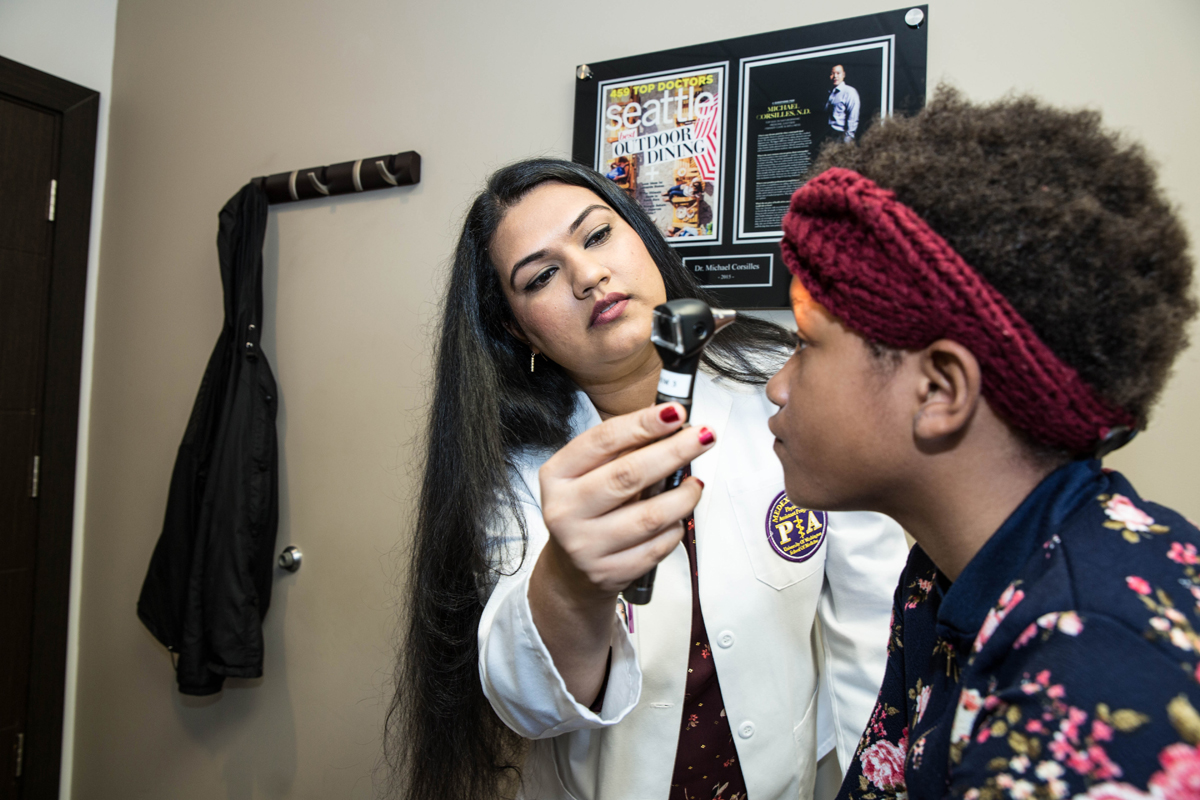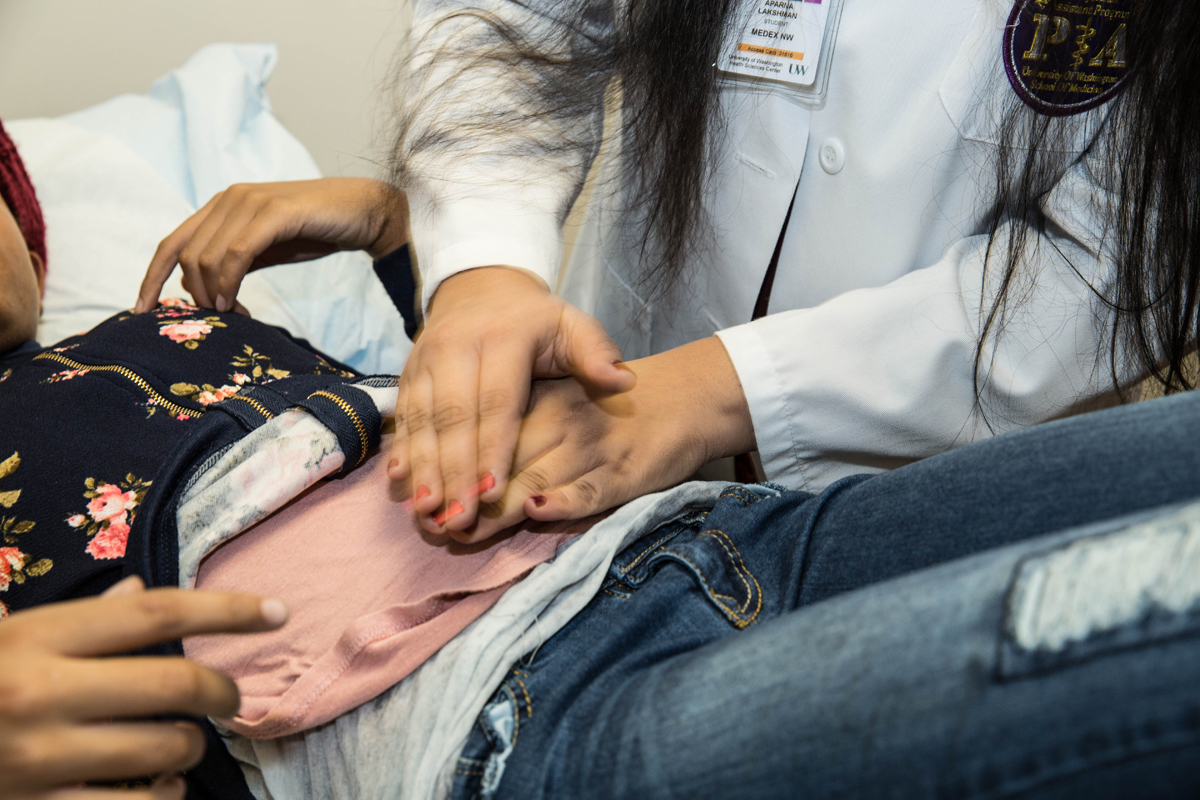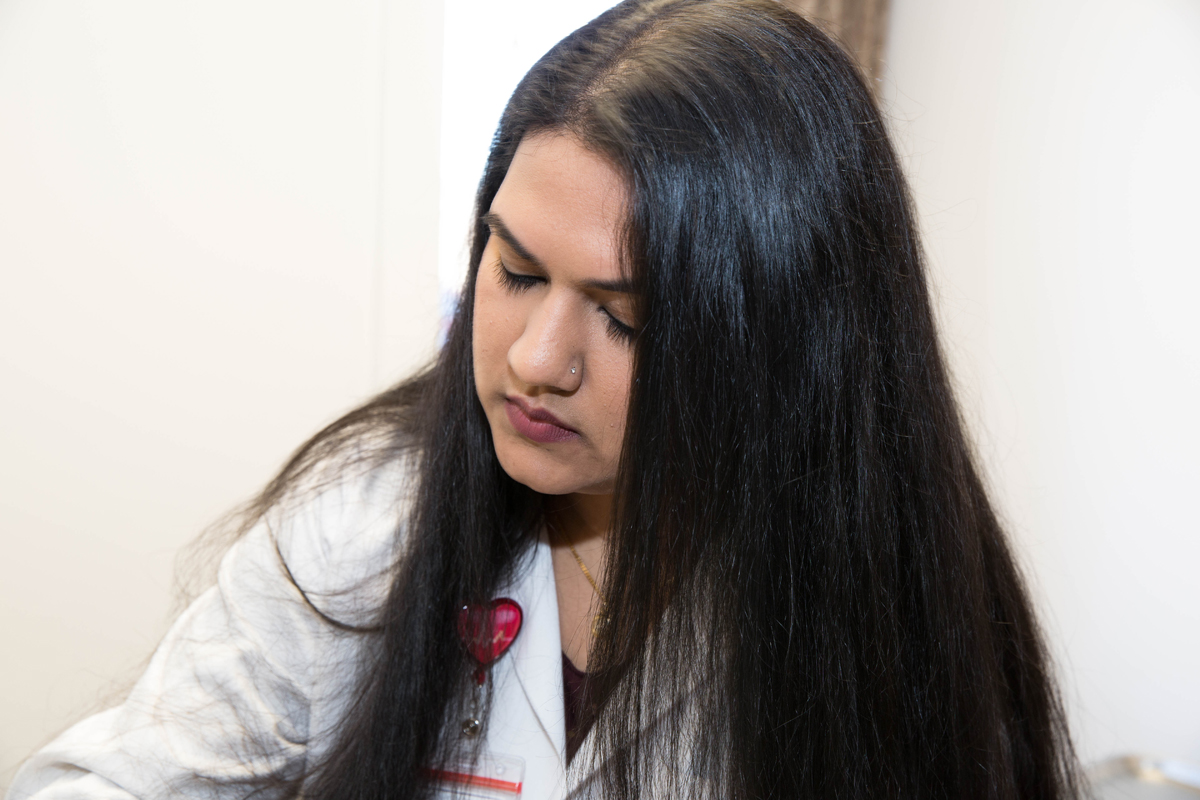As a child growing up in the country of Oman, Aparna Lakshman was fascinated by the doctor who treated her recurring colds and ear infections.
“This person just cured me,” Aparna says, still with a sense of wonder in her voice. “But he did it in such a way that I never felt intimidated. And that’s something that sparked an interest. I’m like, ‘Wow, not only is he, like, making me feel better, but he actually makes me feel better as a person too. He doesn’t treat me like a sick person, he treats me with loving, tender care.’ That’s something that always stayed in my head.”
Aparna was born in India but spent the first 18 years of her life in Oman, years marked by yearly vacations back to India. She was educated in a private Indian school in Oman. “There’s a huge Indian population there,” she says.
But regular access to medical services proved challenging where she grew up in the Middle East.
“There were hardly any medical professionals. I remember my parents taking me to a local Omani clinic for well child checkups and injections. At the time the large hospitals didn’t have translators, and I watched my parents struggle. We had to find an Indian doctor and travel to them so that my parents could understand.”
There is no history of immediate medical professionals in Aparna’s family. And yet, for as long as she can remember, Aparna was drawn to medicine. “My favorite toy was the little doctor kit with the stethoscope and the fake otoscope,” she says. “No one told me that I had to become a medical professional. It was just in me. I just felt like that’s what I was supposed to do in a professional realm– help others. Not only help, but relate to patients in a way that they don’t get from other people.”
Initially, Aparna considered nursing, then shifted her focus to medical school. “I wanted to be a physician for the longest time,” she says.
High school in Oman ended at age 16, and Aparna was a year into college when the family decided to relocate geographically.
Aparna’s father worked for the U.S. Embassy in Oman. After 23 years of service with the U.S. State Department, Aparna’s father qualified for a Special Immigrant Visa. It’s a privilege that would give him and the family permanent residence in the United States. “So, my dad quit his nice job and we had to uproot our lives and start from scratch,” Aparna explains. All this at age 18.
“It was my mom, my younger sister, and my dad and me. We filled luggage with our hopes and dreams, squeezed in with all our clothes. That’s all we had.” The family moved to Kent, the new home for many immigrants within Washington State. “My dad knew someone in that area,” she says. “So that’s why we started in Kent. We rented an apartment, and we’ve been there ever since.”
There were struggles at first, but Mr. Lakshman was able to get back in the workforce quickly. But with the rise in costs by coming to America, his salary wasn’t quite enough to support the family of four. At that time, Aparna’s mother had never worked in her life. She had married young and not gone to school since marriage.
“Nobody ever encouraged her to find her own identity,” says Aparna. She pushed her mother to go back to school. “And that’s something I take so much pride in.” Her mother’s English improved. “I saw her grow as a person. Now she’s a preschool teacher. She feels so much better and is earning an income. She says, ‘It’s my money? My own money? I can do anything with it?’ I’m like, ‘Yeah, mom, it’s your money.’ The transformation in her has been such a delight.”
Aparna’s own path to education in the US began at Bellevue Community College soon after her arrival at age 18. There, she obtained the prerequisites needed for a transfer to the University of Washington, where she was fully committed to the premed path and a future as doctor.
Close to the end of her senior year at UW, Aparna was taking the MCAT (Medical College Admission Test) and working on her applications for medical school. “I did all of that,” she says. “But I never completed it. I was kind of hard on myself. But now, looking back, I can see it was the best decision because I have a better future ahead of me as a PA.”
Aparna’s understanding of the physician assistant profession traced back to her undergraduate life. She received a global scholarship to study abroad and went to India for a quarter. Her roommate was a PA from New Jersey who was in her clinical year at the time.
“She really took the time to explain to me, ‘This is what a PA does.’ She was studying for her PANCE at that time. I remember looking at her PANCE book thinking, ‘This looks a lot like medical school.’. I wasn’t sure what they did, because I was of the notion that maybe their scope of practice was much narrower.”
Turns out the opposite was true. Unlike an MD, a PA isn’t locked into one area of medicine.
“If you’re a cardiologist, that’s what you are. It’s so hard to change residencies; you’re set on one field. With physician assistant, I saw the opportunities are almost endless. You have a long time to do things. You can change fields. And there’s so many opportunities out there.”
In order to get into PA school, Aparna had to log a certain number of patient contact hours. She got her medical assisting license and started at a retina clinic in Federal Way. This was followed by three years at bariatric clinic under Dr. Thien Nguyen.
“There was a lot of patient interaction,’ she says. More than that, Dr. Nguyen afforded Aparna the opportunity to put into practice everything she’d learned in premed. This included a lot of back and forth, with discussion about patient care and needs, providing her with a strong foundation for PA school.
In the end, Aparna clocked over 4,000 hours of patient contact as a medical assistant. MEDEX requires 2,000. At the bariatric clinic Aparna had become acquainted with several MEDEX PA students who came through on one-month surgical rotations under Dr. Nguyen. She’d seen their competence, and the respect the providers afforded them.
Initially, Aparna applied to MEDEX Northwest in 2014, even though it was late in the application season and her prerequisites were not entirely in order. During the second application round in 2015, Aparna expanded to include several other PA schools and was invited to five interviews. But when the University of Washington-based MEDEX Northwest program granted her an interview, she felt a sense of relief and excitement. “It was like, ‘All the lords have heard my prayers. This is the moment I’ve been waiting for all my life.’ I didn’t think twice, went for the interview, tried my best and got in. That was the happiest day of my life. Finally, I got some control over my future. Now I know where I’m going, and I’m doing a positive change in my life. It all just came together.”
The first year of the two-year program is spent in the classroom. Aparna describes the didactic year as a rough one. “Rough in the sense of the content and the acceleration of the program,” she says. “It’s from zero to 100, really quickly. So much information, so quick. I can’t believe I finished the didactic year and that thick book. I’m proud of myself that I made it through because it’s one of the hardest things I’ve done. But at the same time, I think it kind of tested me also. It was like, how much can I do? How can I hold this amount of stress? But, you know, I came out sane, which I think is a victory by itself.”
About her cohorts from MEDEX Seattle Class 50, Aparna has found them to be down-to-earth. “I can reach out to any of my classmates, at any time, and know they will somehow, in some way, help me. We have ER techs, paramedics, MAs and a pharmacist in our class. I’m able to tap into each of them for their own expertise. I really like that.”
Presently in her clinical year, Aparna is in her 4-month family medicine preceptorship at Eastside Primary Care and Wellness under Michael Corsilles, ND, PA-C. Himself a MEDEX graduate of MEDEX Seattle Class 42 from 2010, Dr. Corsilles has the distinction of being both a physician assistant and a naturopath.
“He has such a tender heart,” says Aparna, speaking of Dr. Corsilles. “I feel like we have more of a friendship because he’s just so open, and we joke. If I make mistakes, I can make them openly. And that is something I’ve considered to be very important. He’s very gentle about correcting me and giving good feedback. This clinic has been amazing.”
Aparna has six additional one-month rotations before she graduates in August of 2018, including one at Harborview in behavioral medicine and inpatient medicine with the bone marrow transplant unit at Seattle Cancer Care Alliance.
As for the future, Aparna imagines starting off her career as a physician assistant in family medicine.
“I know that for sure. I definitely want a nice foundation for my education. I know it’s a steep learning curve, but it’s a good base. People say, ‘Primary care, it’s always coughs and colds.’ But for me every person is so different. This person’s cough is not the same as the other person’s cough. And in family medicine, you really get to know the person you’re treating. You see them annually, you manage their diabetes, and you manage their hypertension. Somehow, that just excites me. It really does.”
It’s clear that Aparna enjoys patient feedback. She speaks about the power of interaction, of inspiring confidence by listening to and helping the patient, especially if they’re in pain. Perhaps this echoes back to her earliest experience as a child with a doctor in Oman.
“I really look forward to being a good provider,” she says. “It doesn’t matter how I did on a test. At the end of the day, it’s not just practicing medicine, it’s really about practicing people. I say ‘practicing people’ because it’s the patient skills that matter. How can I help them, and how can I make their day better?”




